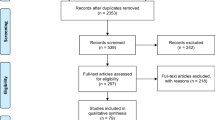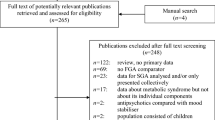Abstract
Purpose of Review
To critically review the current landscape of literature on cardiotoxicity of “new-generation antipsychotics,” defined as those approved by the Food and Drug Administration in the last 10 years.
Recent Findings
There is a paucity of data regarding the cardiovascular risks of these medications. Based on the investigations that have been published, iloperidone appears to be the greatest risk of corrected QT prolongation followed by asenapine whereas lurasidone, cariprazine, and brexpiprazole were not found to have significant effects on corrected QT. However, the evidence was low quality. In terms of metabolic effects, asenapine, iloperidone, cariprazine, and brexpiprazole all had mild to moderate effects whereas lurasidone had no significant effects observed.
Summary
Further investigation is warranted for all of these medications to better understand their cardiovascular effects.
Similar content being viewed by others
References and Recommended Reading
Papers of particular interest, published recently, have been highlighted as: • Of importance
Simeone JC, Ward AJ, Rotella P, Collins J, Windisch R. An evaluation of variation in published estimates of schizophrenia prevalence from 1990 horizontal line 2013: a systematic literature review. BMC Psychiatry. 2015;15:193. https://doi.org/10.1186/s12888-015-0578-7.
Remington G, Addington D, Honer W, Ismail Z, Raedler T, Teehan M. Guidelines for the pharmacotherapy of schizophrenia in adults. Can J Psychiatr. 2017;62(9):604–16. https://doi.org/10.1177/0706743717720448.
Zhang Y, Liu Y, Su Y, You Y, Ma Y, Yang G, et al. The metabolic side effects of 12 antipsychotic drugs used for the treatment of schizophrenia on glucose: a network meta-analysis. BMC Psychiatry. 2017;17(1):373. https://doi.org/10.1186/s12888-017-1539-0.Important non-industry sponsored network meta-anaylsis that compares the metabolic effects of 12 different antipsychotic medications.
Rummel-Kluge C, Komossa K, Schwarz S, Hunger H, Schmid F, Kissling W, et al. Second-generation antipsychotic drugs and extrapyramidal side effects: a systematic review and meta-analysis of head-to-head comparisons. Schizophr Bull. 2012;38(1):167–77. https://doi.org/10.1093/schbul/sbq042.
Stoner SC. Management of serious cardiac adverse effects of antipsychotic medications. Ment Health Clin. 2017;7(6):246–54. https://doi.org/10.9740/mhc.2017.11.246.Brief but thorough education focused article centered on treatment of antipsychotic related cardiovacsular toxicity.
Polcwiartek C, Kragholm K, Schjerning O, Graff C, Nielsen J. Cardiovascular safety of antipsychotics: a clinical overview. Expert Opin Drug Saf. 2016;15(5):679–88. https://doi.org/10.1517/14740338.2016.1161021.
Vieta E, Montes JM. A review of asenapine in the treatment of bipolar disorder. Clin Drug Investig. 2018;38(2):87–99. https://doi.org/10.1007/s40261-017-0592-2.
Durgam S, Landbloom RP, Mackle M, Wu X, Mathews M, Nasrallah HA. Exploring the long-term safety of asenapine in adults with schizophrenia in a double-blind, fixed-dose, extension study. Neuropsychiatr Dis Treat. 2017;13:2021–35. https://doi.org/10.2147/NDT.S130211.Although industry sponsored, this study with 120 patients across multiple sites compares tolerability of low-dose asenapine, high-dose asenapine, and olanzapine.
Potkin SG. Asenapine: a clinical overview. J Clin Psychiatry. 2011;72(Suppl 1):14–8. https://doi.org/10.4088/JCP.10075su1.03.
Chapel S, Hutmacher MM, Haig G, Bockbrader H, de Greef R, Preskorn SH, et al. Exposure-response analysis in patients with schizophrenia to assess the effect of asenapine on QTc prolongation. J Clin Pharmacol. 2009;49(11):1297–308. https://doi.org/10.1177/0091270009344855.
Kotasek F, Tibrewal P, Dhillon R. QTc prolongation with asenapine. Aust N Z J Psychiatry. 2014;48(10):961. https://doi.org/10.1177/0004867414531832.
Potkin SG, Cohen M, Panagides J. Efficacy and tolerability of asenapine in acute schizophrenia: a placebo- and risperidone-controlled trial. J Clin Psychiatry. 2007;68(10):1492–500.
Gill JS, Sulaiman AH. QTc prolongation and ventricular trigemini with asenapine: a case report. Turk Psikiyatri Derg. 2018;29(1):67–8.
Grossini E, Gramaglia C, Farruggio S, Camillo L, Mary D, Vacca G, et al. Asenapine modulates nitric oxide release and calcium movements in cardiomyoblasts. J Pharmacol Pharmacother. 2016;7(1):6–14. https://doi.org/10.4103/0976-500X.179358.
Grossini E, Gramaglia C, Farruggio S, Bellofatto K, Anchisi C, Mary D, et al. Asenapine increases nitric oxide release and protects porcine coronary artery endothelial cells against peroxidation. Vasc Pharmacol. 2014;60(3):127–41. https://doi.org/10.1016/j.vph.2014.01.008.
Lim X, Tibrewal P, Dhillon R, Bastiampillai T, Chen L, Lin A. Can asenapine cause myocarditis? Asian J Psychiatr. 2015;14:78–9. https://doi.org/10.1016/j.ajp.2015.03.002.
Kemp DE, Zhao J, Cazorla P, Landbloom RP, Mackle M, Snow-Adami L, et al. Weight change and metabolic effects of asenapine in patients with schizophrenia and bipolar disorder. J Clin Psychiatry. 2014;75(3):238–45. https://doi.org/10.4088/JCP.12m08271.
Kane JM, Cohen M, Zhao J, Alphs L, Panagides J. Efficacy and safety of asenapine in a placebo- and haloperidol-controlled trial in patients with acute exacerbation of schizophrenia. J Clin Psychopharmacol. 2010;30(2):106–15. https://doi.org/10.1097/JCP.0b013e3181d35d6b.
Stepanova E, Grant B, Findling RL. Asenapine treatment in pediatric patients with bipolar I disorder or schizophrenia: a review. Paediatr Drugs. 2018;20(2):121–34. https://doi.org/10.1007/s40272-017-0274-9.
Mathis MV. FDA Summar Review: Iloperidone. In: (FDA) FaDA, editor.2009. p. 1–21. https://www.accessdata.fda.gov/drugsatfda_docs/label/2016/022192s017lbl.pdf.
Kane JM, Lauriello J, Laska E, Di Marino M, Wolfgang CD. Long-term efficacy and safety of iloperidone: results from 3 clinical trials for the treatment of schizophrenia. J Clin Psychopharmacol. 2008;28(2 Suppl 1):S29–35. https://doi.org/10.1097/JCP.0b013e318169cca7.
Tonin FS, Wiens A, Fernandez-Llimos F, Pontarolo R. Iloperidone in the treatment of schizophrenia: an evidence-based review of its place in therapy. Core Evid. 2016;11:49–61. https://doi.org/10.2147/CE.S114094.
Weiden PJ, Manning R, Wolfgang CD, Ryan JM, Mancione L, Han G, et al. A randomized trial of iloperidone for prevention of relapse in schizophrenia: the REPRIEVE study. CNS Drugs. 2016;30(8):735–47. https://doi.org/10.1007/s40263-016-0345-4.
Rado JT, Janicak PG. Long-term efficacy and safety of iloperidone: an update. Neuropsychiatr Dis Treat. 2014;10:409–15. https://doi.org/10.2147/NDT.S37824.
Cutler AJ. Iloperidone: a new option for the treatment of schizophrenia. Expert Rev Neurother. 2009;9(12):1727–41. https://doi.org/10.1002/pmic.200800563.
Citrome L. Iloperidone: a clinical overview. J Clin Psychiatry. 2011;72(Suppl 1):19–23. https://doi.org/10.4088/JCP.10075su1.04.
Citrome L. Iloperidone redux: a dissection of the Drug Approval Package for this newly commercialised second-generation antipsychotic. Int J Clin Pract. 2010;64(6):707–18. https://doi.org/10.1111/j.1742-1241.2010.02344.x.
Citrome L, Weiden PJ, Alva G, Glick ID, Jackson R, Mattingly G, et al. Switching to iloperidone: an omnibus of clinically relevant observations from a 12-week, open-label, randomized clinical trial in 500 persons with schizophrenia. Clin Schizophr Relat Psychoses. 2015;8(4):183–95. https://doi.org/10.3371/CSRP.CIWE.103114.
Cutler AJ, Kalali AH, Mattingly GW, Kunovac J, Meng X. Long-term safety and tolerability of iloperidone: results from a 25-week, open-label extension trial. CNS Spectr. 2013;18(1):43–54. https://doi.org/10.1017/S1092852912000764.
Mathis MV. FDA Summary review: lurasidone. In: (FDA) FaDA, editor. 2010. https://www.accessdata.fda.gov/drugsatfda_docs/label/2013/200603lbls10s11.pdf.
Meyer JM, Loebel AD, Schweizer E. Lurasidone: a new drug in development for schizophrenia. Expert Opin Investig Drugs. 2009;18(11):1715–26. https://doi.org/10.1517/13543780903286388.
Nakamura M, Ogasa M, Guarino J, Phillips D, Severs J, Cucchiaro J, et al. Lurasidone in the treatment of acute schizophrenia: a double-blind, placebo-controlled trial. J Clin Psychiatry. 2009;70(6):829–36. https://doi.org/10.4088/JCP.08m04905.
Ogasa M, Kimura T, Nakamura M, Guarino J. Lurasidone in the treatment of schizophrenia: a 6-week, placebo-controlled study. Psychopharmacology. 2013;225(3):519–30. https://doi.org/10.1007/s00213-012-2838-2.
Mathis MV. FDA summary review: cariprazine. 2015. https://www.accessdata.fda.gov/drugsatfda_docs/label/2015/204370lbl.pdf.
Girgis RR, Slifstein M, D’Souza D, Lee Y, Periclou A, Ghahramani P, et al. Preferential binding to dopamine D3 over D2 receptors by cariprazine in patients with schizophrenia using PET with the D3/D2 receptor ligand [(11)C]-(+)-PHNO. Psychopharmacology. 2016;233(19–20):3503–12. https://doi.org/10.1007/s00213-016-4382-y.
Kiss B, Horvath A, Nemethy Z, Schmidt E, Laszlovszky I, Bugovics G, et al. Cariprazine (RGH-188), a dopamine D(3) receptor-preferring, D(3)/D(2) dopamine receptor antagonist-partial agonist antipsychotic candidate: in vitro and neurochemical profile. J Pharmacol Exp Ther. 2010;333(1):328–40. https://doi.org/10.1124/jpet.109.160432.
Lao KS, He Y, Wong IC, Besag FM, Chan EW. Tolerability and safety profile of cariprazine in treating psychotic disorders, bipolar disorder and major depressive disorder: a systematic review with meta-analysis of randomized controlled trials. CNS Drugs. 2016;30(11):1043–54. https://doi.org/10.1007/s40263-016-0382-z.
Durgam S, Greenberg WM, Li D, Lu K, Laszlovszky I, Nemeth G, et al. Safety and tolerability of cariprazine in the long-term treatment of schizophrenia: results from a 48-week, single-arm, open-label extension study. Psychopharmacology. 2017;234(2):199–209. https://doi.org/10.1007/s00213-016-4450-3.
Cutler AJ, Durgam S, Wang Y, Migliore R, Lu K, Laszlovszky I, et al. Evaluation of the long-term safety and tolerability of cariprazine in patients with schizophrenia: results from a 1-year open-label study. CNS Spectr. 2018;23(1):39–50. https://doi.org/10.1017/S1092852917000220.
Nasrallah HA, Earley W, Cutler AJ, Wang Y, Lu K, Laszlovszky I, et al. The safety and tolerability of cariprazine in long-term treatment of schizophrenia: a post hoc pooled analysis. BMC Psychiatry. 2017;17(1):305. https://doi.org/10.1186/s12888-017-1459-z.
Vieta E, Earley WR, Burgess MV, Durgam S, Chen C, Zhong Y, et al. Long-term safety and tolerability of cariprazine as adjunctive therapy in major depressive disorder. Int Clin Psychopharmacol. 2019;34(2):76–83. https://doi.org/10.1097/YIC.0000000000000246.
Mathis MV. FDA summary review: brexpiprazole. 2015. p. 1–17.
Citrome L. A review of the pharmacology, efficacy and tolerability of recently approved and upcoming oral antipsychotics: an evidence-based medicine approach. CNS Drugs. 2013;27(11):879–911. https://doi.org/10.1007/s40263-013-0105-7.
Stahl SM. Mechanism of action of brexpiprazole: comparison with aripiprazole. CNS Spectr. 2016;21(1):1–6. https://doi.org/10.1017/S1092852915000954.
Aronow WS, Shamliyan TA. Effects of atypical antipsychotic drugs on QT interval in patients with mental disorders. Ann Transl Med. 2018;6(8):147. https://doi.org/10.21037/atm.2018.03.17.
Citrome L. Brexpiprazole for schizophrenia and as adjunct for major depressive disorder: a systematic review of the efficacy and safety profile for this newly approved antipsychotic - what is the number needed to treat, number needed to harm and likelihood to be helped or harmed? Int J Clin Pract. 2015;69(9):978–97. https://doi.org/10.1111/ijcp.12714.
Acknowledgments
We would like to acknowledge Elaine Alligood for her assistance in literature search and article access.
Author information
Authors and Affiliations
Corresponding author
Ethics declarations
Conflict of Interest
Aishwarya K. Rajagopalan, William K. Bache, Serena Z. Chen, Ermal Bojdani, and Kevin J. Li declare that they have no conflict of interest.
Human and Animal Rights and Informed Consent
This article does not contain any studies with human or animal subjects performed by any of the authors.
Additional information
Publisher’s Note
Springer Nature remains neutral with regard to jurisdictional claims in published maps and institutional affiliations.
This article is part of the Topical Collection on Schizophrenia and Other Psychotic Disorders
Rights and permissions
About this article
Cite this article
Rajagopalan, A.K., Bache, W.K., Chen, S.Z. et al. New-generation Antipsychotics and Cardiovascular Risk. Curr Treat Options Psych 6, 154–163 (2019). https://doi.org/10.1007/s40501-019-00173-z
Published:
Issue Date:
DOI: https://doi.org/10.1007/s40501-019-00173-z




